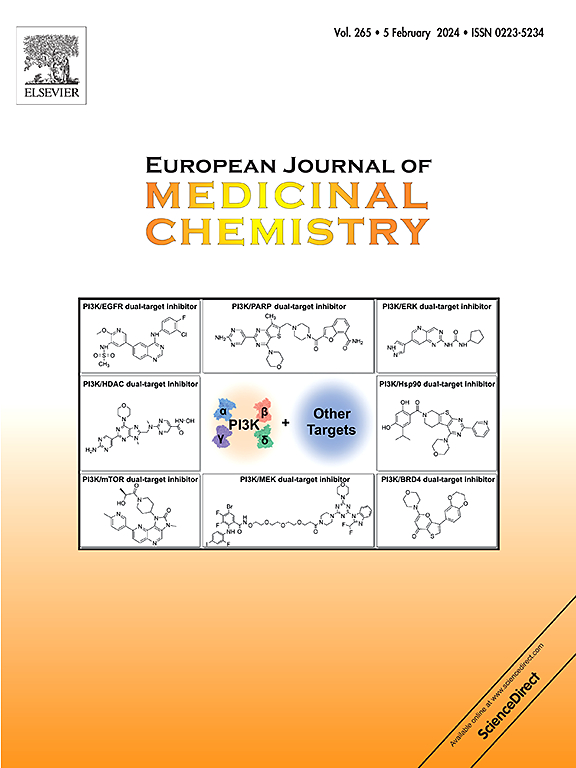放射性标记2-氧-2-(4-苯基哌嗪-1-酰基)乙酰胺衍生物作为兴奋性氨基酸转运蛋白潜在分子探针的研究进展
IF 6
2区 医学
Q1 CHEMISTRY, MEDICINAL
引用次数: 0
摘要
兴奋性氨基酸转运蛋白2 (EAAT2)是一个很有吸引力的药物开发靶点,因为它在生理条件下的突触谷氨酸转运中起着至关重要的作用,其功能障碍与神经变性有关。在本研究中,我们设计并合成了一系列2-氧-2-(4-苯基哌嗪-1-基)乙酰胺衍生物作为新型EAAT2正变构调节剂(pam)。[131I]2 ([131I]SF-1)被成功开发为一种有价值的体外竞争性结合测定工具。结构亲和关系鉴定出化合物4的抑制常数为29 nM。在离体生物分布研究中,[18F]4 ([18F]SF-2)在啮齿动物大脑中表现出良好的脑穿透性和充分的可逆性。用冷参比或先前报道的EAAT2 pam进行预处理可显著降低脑和脊髓中的放射性积累,证实其在体内的高特异性。这些发现为直接测量新结构与EAAT2的相互作用提供了有价值的分子探针,并为通过PET神经成像无创监测EAAT2表达提供了机会。本文章由计算机程序翻译,如有差异,请以英文原文为准。


Development of radiolabeling 2-oxo-2-(4-phenylpiperazin-1-yl)acetamide derivatives as potential molecular probes for excitatory amino acid transporter 2
Excitatory amino acid transporter 2 (EAAT2) is an appealing target for drug development, as it plays a crucial role in synaptic glutamate transport under physiological conditions and its malfunction is implicated in neurodegenerations. In this study, we designed and synthesized a series of 2-oxo-2-(4-phenylpiperazin-1-yl)acetamide derivatives as novel EAAT2 positive allosteric modulators (PAMs). [131I]2 ([131I]SF-1) was successfully developed as a valuable tool for in vitro competitive binding assay. Structure-affinity relationship led to the identification of compound 4 with an inhibitory constant of 29 nM. In ex vivo biodistribution studies, [18F]4 ([18F]SF-2) exhibited excellent brain penetration and sufficient reversibility in the rodent brains. Pretreatment with cold reference or previously reported EAAT2 PAMs resulted in significant reductions of radioactivity accumulations in the brain and spinal cord, confirming its high specificity in vivo. These findings present a valuable molecular probe to directly measure the interactions of the novel structures with EAAT2 and open an opportunity to non-invasively monitor EAAT2 expression through PET neuroimaging.
求助全文
通过发布文献求助,成功后即可免费获取论文全文。
去求助
来源期刊
CiteScore
11.70
自引率
9.00%
发文量
863
审稿时长
29 days
期刊介绍:
The European Journal of Medicinal Chemistry is a global journal that publishes studies on all aspects of medicinal chemistry. It provides a medium for publication of original papers and also welcomes critical review papers.
A typical paper would report on the organic synthesis, characterization and pharmacological evaluation of compounds. Other topics of interest are drug design, QSAR, molecular modeling, drug-receptor interactions, molecular aspects of drug metabolism, prodrug synthesis and drug targeting. The journal expects manuscripts to present the rational for a study, provide insight into the design of compounds or understanding of mechanism, or clarify the targets.

 求助内容:
求助内容: 应助结果提醒方式:
应助结果提醒方式:


